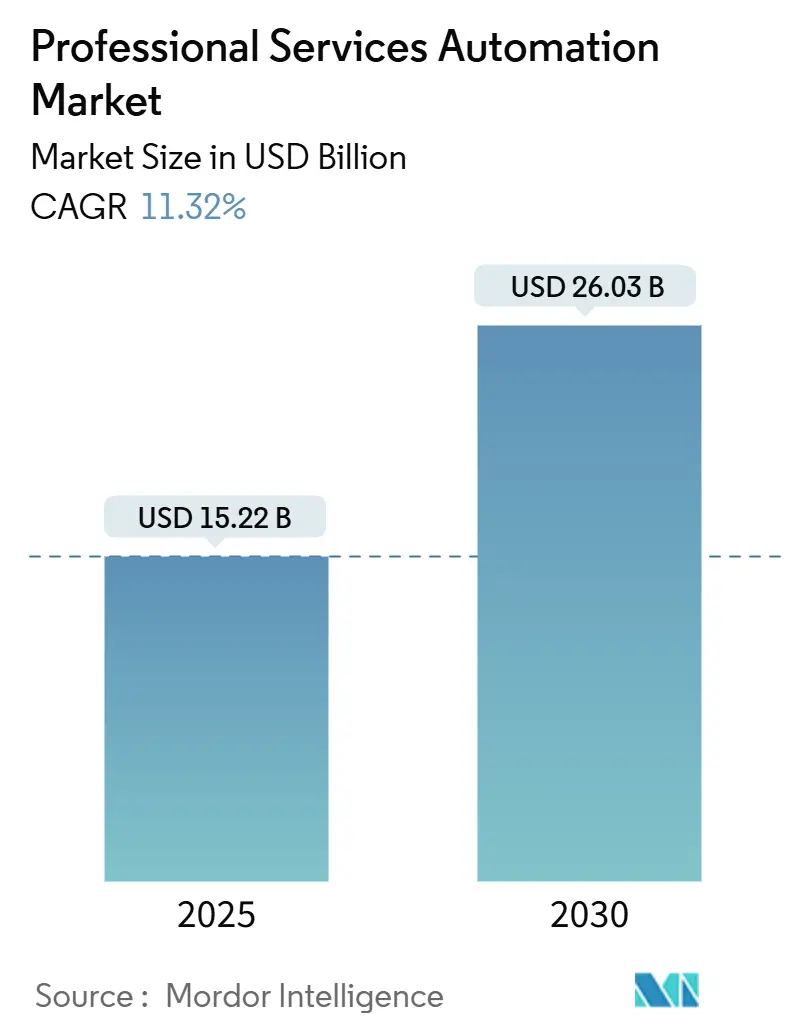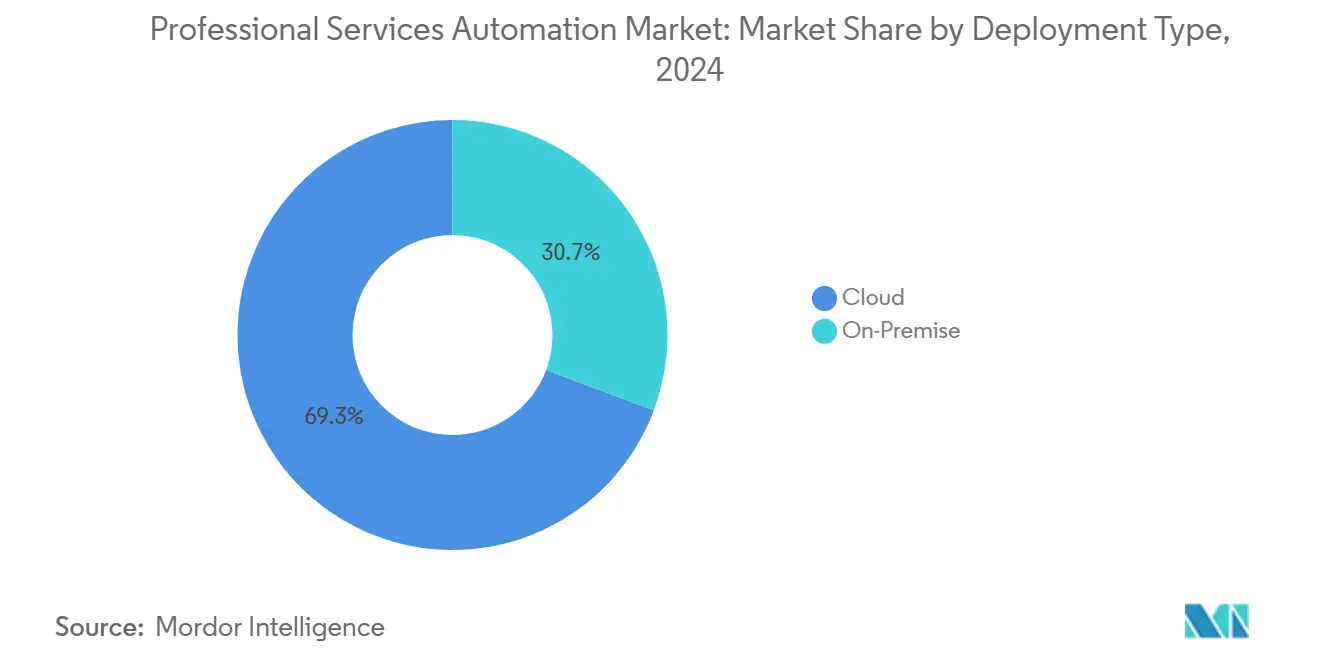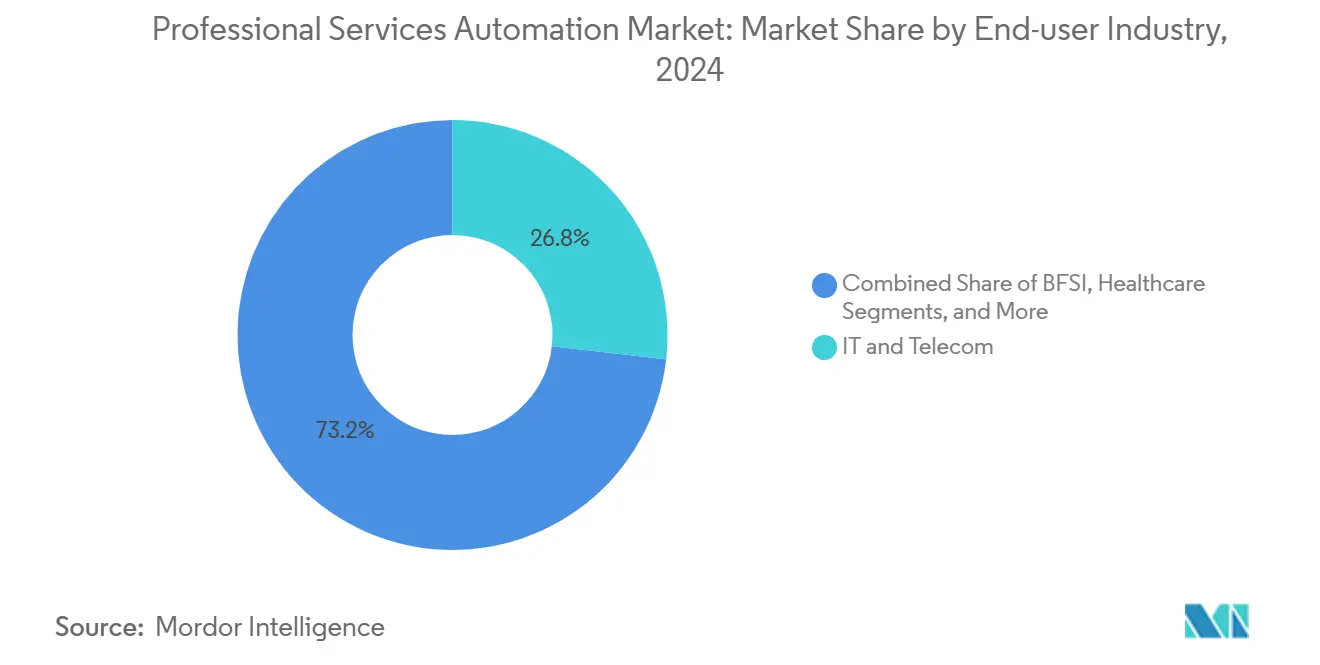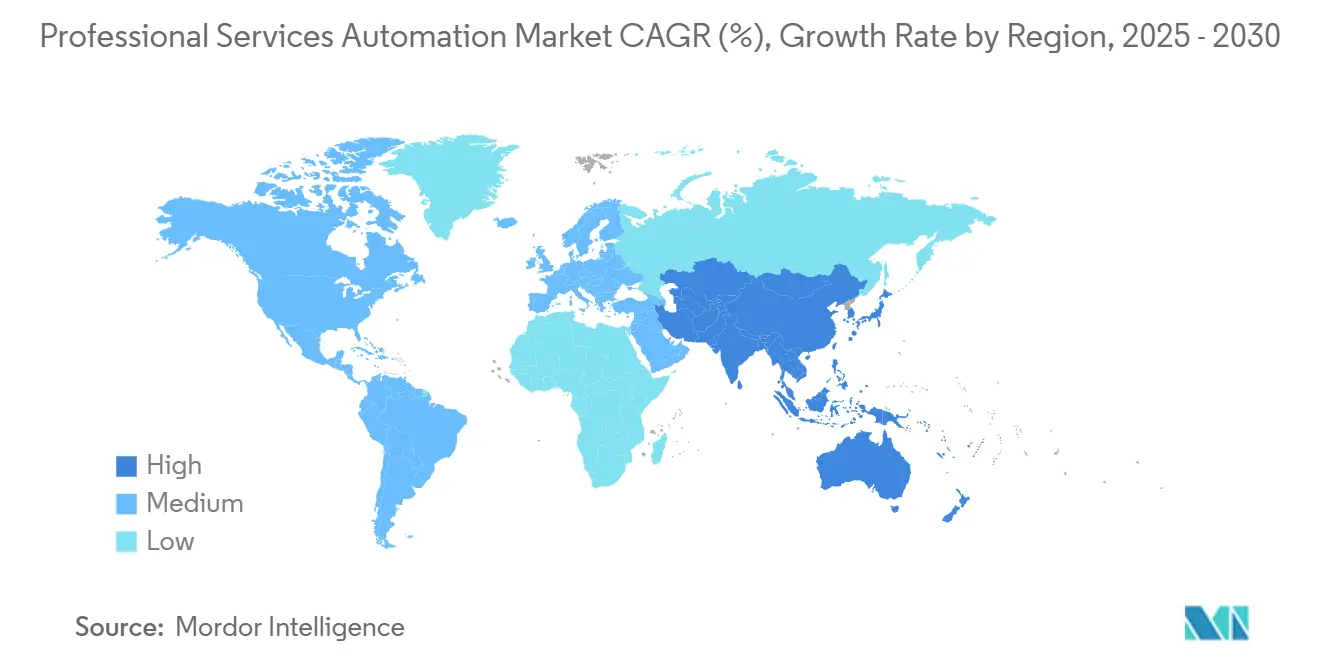Professional Services Automation Market Size and Share

Professional Services Automation Market Analysis by Mordor Intelligence
The Professional Services Automation Market size is estimated at USD 15.22 billion in 2025, and is expected to reach USD 26.03 billion by 2030, at a CAGR of 11.32% during the forecast period (2025-2030). Cloud-first transformation, AI-driven workflow orchestration, and the need for unified project-to-cash visibility anchor this expansion. Firms race to embed predictive analytics that guide staffing, margin management, and client outcomes, while outcome-based billing models spur richer performance measurement capabilities. A 69.3% cloud deployment footprint in 2024 proves that scalable, subscription-based delivery now underpins most new implementations, and AI modules that surface utilization risks before month-end close accelerate decision cycles. As talent shortages persist, vendors differentiate through low-code configuration, embedded best-practice templates, and tight ERP/CRM connectors that de-risk complex rollouts. Competitive advantage hinges on platform breadth: suites that combine project management, resourcing, billing, and analytics in one workspace capture larger seat counts and drive expansion revenue.
Key Report Takeaways
- By deployment type, cloud commanded 69.3% revenue share in 2024 and is projected to grow at a 13.2% CAGR through 2030.
- By component, solutions accounted for 61.6% of 2024 revenue, while the services segment is forecast to expand at a 13.7% CAGR to 2030.
- By enterprise size, large enterprises contributed 59.8% of 2024 revenue, whereas SMEs are set to grow at a 15.3% CAGR through 2030.
- By functionality module, project and resource management led with 34.7% share in 2024; business analytics and reporting is advancing fastest at a 15.8% CAGR to 2030.
- By end-user industry, IT and telecom held 26.8% of 2024 revenue, while consulting and advisory is projected to post the highest 14.1% CAGR through 2030.
- By geography, North America captured 38.06% of 2024 revenue, but Asia-Pacific is expected to expand at a 14.5% CAGR through 2030.
Global Professional Services Automation Market Trends and Insights
Drivers Impact Analysis
| Driver | (~) % Impact on CAGR Forecast | Geographic Relevance | Impact Timeline |
|---|---|---|---|
| Cloud PSA adoption among SMEs | +2.8% | Global, concentration in APAC and Europe | Medium term (2-4 years) |
| Drive for real-time resource and margin visibility | +2.1% | North America and EU, expanding to APAC | Short term (≤ 2 years) |
| ERP/CRM integration momentum | +1.9% | Global, led by North America | Medium term (2-4 years) |
| Shift to outcome-based service models | +1.7% | North America and EU core markets | Long term (≥ 4 years) |
| AI-driven predictive staffing analytics | +2.3% | Global, early adoption in North America | Medium term (2-4 years) |
| Source: Mordor Intelligence | |||
Cloud PSA Adoption Among SMEs
Small and medium enterprises propel the most dynamic growth in the professional services automation market as public-sector digitization grants and easy SaaS onboarding dismantle historical infrastructure hurdles. Singapore’s Productivity Solutions Grant reimburses up to 50% of subscription fees, letting micro-firms access capabilities once reserved for global consultancies. [1]SCS CPA, “PSG for Xero | Claim Up to 50% Grant | Cloud Accounting,” scs-cpa.com A referral flywheel forms as early wins showcase productivity boosts, and subscription pricing converts upfront CAPEX into manageable OPEX, giving vendors recurring cash flows that fund feature velocity. Jana Small Finance Bank cut turnaround time by 65-70% after deploying UiPath’s automation suite. Such results validate the thesis that even a 10-seat firm can wield enterprise-grade orchestration, reshaping competitive parity across professional services segments.
Drive for Real-Time Resource and Margin Visibility
Macroeconomic volatility forces firms to expose utilization gaps and margin leaks in real time rather than at quarterly review. BeyondTrust lifted resource utilization 20% after adopting Certinia PSA, pairing granular skills matrices with live feedback loops. Dashboards that surface over-allocated engineers or under-funded milestones curb cost overruns before they erode profitability. As more project teams work across time zones, instantaneous variance alerts allow managers to re-sequence tasks without breaching delivery windows. Embedded AI simulators pressure-test resourcing scenarios, ensuring that rate-card discounts or scope changes do not dilute forecasted gross margin.
ERP/CRM Integration Momentum
The professional services automation market relies on bidirectional data flow with core finance and customer systems; otherwise, project-to-cash remains fragmented. ServiceNow and Oracle now stream records between Workflow Data Fabric and Oracle Autonomous Database to synchronize contracts, costs, and invoices in near real-time. When milestone completion data is published directly into revenue recognition ledgers, billing latency collapses, and CFOs gain accurate day-zero cash forecasting. However, heterogeneous legacy stacks push implementation timelines as data governance and process realignment create cross-functional dependencies that smaller firms sometimes underestimate.
AI-Driven Predictive Staffing Analytics
Resource planning shifts from reactive to anticipatory as vendors embed context-aware algorithms. Oracle NetSuite’s SuiteProjects Pro evaluates historical burn rates and skill inventory to propose staffing options that maximize utilization. [2]Oracle NetSuite, “NetSuite 2025.1 Features New Procurement Solution,” netsuite.com Workday’s Agent System of Record houses AI agents beside human consultants, enabling hybrid teams where bots tackle repetitive reconciliations while specialists focus on advisory tasks. These advances shorten bench time, elevate billable hours, and align learning paths with emergent demand—each reinforcing platform stickiness.
Restraints Impact Analysis
| Restraint | (~) % Impact on CAGR Forecast | Geographic Relevance | Impact Timeline |
|---|---|---|---|
| Data-privacy concerns in multi-tenant clouds | -1.4% | EU (GDPR), expanding globally | Short term (≤ 2 years) |
| Integration complexity with legacy stacks | -1.8% | Global, acute in large enterprises | Medium term (2-4 years) |
| Scarcity of PSA-skilled implementation talent | -1.1% | North America and EU | Medium term (2-4 years) |
| Vendor consolidation and lock-in risk | -0.9% | Global, concentrated in mid-market | Long term (≥ 4 years) |
| Source: Mordor Intelligence | |||
Data-Privacy Concerns in Multi-Tenant Clouds
GDPR imposes strict residency and consent rules that intensify scrutiny of shared-tenant architectures handling client records, project notes, and employee timesheets. Regulated advisory practices now negotiate data-processing addendums that stipulate encryption keys, regional failover, and audit-ready logging. While hyperscale clouds boast SOC 2 and ISO-27001 attestations, some clients still prefer single-tenant or EU sovereign zones, delaying pure-cloud migrations and marginally dampening professional services automation market adoption in the short term.
Integration Complexity with Legacy Stacks
Decades-old ERP deployments often lack modern APIs, forcing middleware workarounds that inflate project costs. The Revlon ERP collapse highlighted the financial risk of under-scoped integration efforts. Projects frequently run dual-process modes—manual spreadsheets for payroll alongside emerging PSA workflows—until cut-over, prolonging change fatigue. Scarcity of specialists versed in both COBOL-era financials and contemporary PSA schemas further strains timelines and raises contract rates, tempering the otherwise robust trajectory of the professional services automation market.
Segment Analysis
By Deployment Type: Cloud Dominance Accelerates
Cloud deployments represented 69.3% of the professional services automation market size in 2024 and are slated to grow at 13.2% CAGR to 2030, reflecting a decisive pivot from on-premise custom builds. Automatic patching, elastic compute, and subscription pricing align with distributed workforce realities and CFO mandates to shift CAPEX to OPEX. On-premise PSA persists in highly regulated niches that mandate behind-firewall data residency, but even there, hybrid adjacency—analytics or mobile time capture in the cloud—gains traction. Platform vendors deepen alliances with AWS and Microsoft to tap global availability zones and shared AI accelerators. These moves compress implementation cycles from quarters to weeks, broadening the total addressable professional services automation market.
Traditional vendors that once relied on perpetual licenses now craft phased migration toolkits, offering data migration utilities and dual-running options that limit downtime. Emerging entrants born in the cloud exploit this inertia by promising zero-footprint deployment, consumption-based billing, and in-product walk-throughs suited to teams without dedicated IT support. As a result, cloud PSA adoption not only displaces legacy tools but can also catalyze first-time PSA buyers in emerging economies, extending the professional services automation market footprint.

By Component: Services Growth Reflects Implementation Complexity
While Solutions retained 61.6% revenue in 2024, the Services segment is expanding at 13.7% CAGR, mirroring the rise in enterprise-wide rollouts that demand process re-engineering, data cleanup, and user enablement. Every new AI module or ERP connector creates a downstream need for configuration, integration, and governance frameworks, and customers often lack the bandwidth to manage this layer themselves. Systems integrators, therefore, carve premium consulting revenue, shaping roadmaps, configuring role-based dashboards, and staging phased cut-overs.
Because successful adoption hinges on behavior change, change-management specialists orchestrate communications, role-play sessions, and KPI dashboards that sustain momentum post go-live. Vendors such as Thirdera became early movers, delivering Workflow Data Fabric accelerators for ServiceNow customers. [3]Thirdera, “Thirdera…Becomes First ServiceNow Partner to Bring Workflow Data Fabric to Market,” thirdera.com The services upturn bolsters average contract value and underpins recurring expansion bookings, solidifying long-term vendor-client relationships within the professional services automation market.
By Enterprise Size: SME Segment Drives Market Expansion
Large enterprises commanded 59.8% of the professional services automation market share in 2024, leveraging volume discounts and complex functionality. Yet SMEs are charting a 15.3% CAGR through 2030 as low-touch onboarding, pay-as-you-grow tiers, and government subsidies create a frictionless runway. Cloud provisioning eliminates multi-week hardware procurement, while guided setup wizards cut implementation times to days, letting a 30-person creative agency track billable hours and deliverables with minimal overhead.
Government stimulus amplifies this motion: Singapore covers up to 50% of qualifying software spend, while India’s upcoming Digital MSME scheme earmarks budget for productivity tooling. Vendors respond with starter editions that bundle core project management, time capture, and invoicing, then upsell AI analytics and client portals as firms scale. This land-and-expand strategy enlarges the bottom-up funnel of the professional services automation market, securing future enterprise conversions.
By End-user Industry: IT and Telecom Leadership with Consulting Acceleration
IT and Telecom contributed 26.8% revenue in 2024, capitalizing on inherent tech fluency and project-centric delivery models. Implementations often integrate agile sprint boards, DevOps metrics, and real-time cost tracking. Consulting and Advisory, however, is the fastest riser at 14.1% CAGR, propelled by clients’ insistence on transparent scope, KPI-tied fees, and auditable deliverables. Firms embed PSA dashboards in client portals to expose milestone progress, resource burn, and change-request impacts, reinforcing trust.
BFSI accelerates adoption to automate stringent compliance workstreams: First Citizens Bank automated 23 processes via Pega RPA, carving substantial back-office savings. [4]Pega, “First Citizens Bank drives seamless automation with Pega RPA,” pega.com Healthcare, legal, and AEC sectors likewise converge on PSA for authority trail, audit readiness, and cross-disciplinary scheduling, demonstrating versatility across professional services verticals. Each verticalization spawns pre-configured templates, expanding the professional services automation market into nuanced industry workflows.

Note: Segment shares of all individual segments available upon report purchase
By Functionality Module: Analytics Growth Signals Intelligence Shift
Project and Resource Management owned 34.7% of the professional services automation market size in 2024, yet Business Analytics and Reporting is surging at 15.8% CAGR. Financial exception detection, driver-based forecasting, and natural-language query interfaces transform static reports into conversational insight engines. Oracle NetSuite now inserts generative AI prompts into its search bar so project managers can ask, “Where will gross margin land this quarter if utilization drops 3%?”. Such capabilities drive seat expansion beyond project controllers to finance, HR, and sales personas.
Time and Expense, Billing, and Knowledge Management remain foundational, but AI-based scenario planners, capacity heat-maps, and automated statement-of-work generators redefine strategic value. Vendors that prioritize open analytics APIs, model explainability, and cross-platform connectors elevate their differentiation, fostering a growth flywheel that reinforces subscription renewals and upsell within the professional services automation market.
Geography Analysis
North America contributed 38.06% of the professional services automation market size in 2024, anchored by mature IT consulting ecosystems, Sarbanes-Oxley controls, and early AI pilot budgets. Headquarters proximity grants many vendors live feedback loops and design-partner engagements that accelerate feature rollouts. Early adopters now progress from departmental pilots to enterprise-wide consolidations, focusing on utilization optimization, advanced profitability modeling, and AI-assisted proposal generation. Although saturation tempers volume growth, cross-selling into analytics, mobile expense, and talent marketplaces sustains revenue lift.
Asia-Pacific is on track for the fastest 14.5% CAGR, backed by government grants, rising wage pressure, and a vibrant SaaS developer base. Japan saw a 157% spike in electronic contract inquiries in 2024, signaling widespread digitization momentum. India’s SaaS firms target an 8% global share by 2028, translating into dual-role participation as both buyers and builders of PSA capabilities. Singapore’s Productivity Solutions Grant and Australia’s focus on AI productivity further energize the regional pipeline. Vendors localize tax, compliance, and language packs to capture these diverse micro-markets.
Europe offers steady uptake tempered by GDPR anxieties. Many advisory practices pursue private-cloud or EU-sovereign deployments, elongating sales but enlarging deal size once procurement hurdles clear. Workday’s GBP 550 million UK investment includes local AWS regions and apprenticeship programs, easing data-residency fears and talent shortages. ESG reporting mandates also catalyze PSA enhancements that capture carbon impact and diversity metrics, positioning the professional services automation market as an enabler of regulatory compliance. Meanwhile, the Middle East and Africa begin to deploy PSA for megaproject oversight—think smart-city builds and infrastructure rollouts—though connectivity gaps and scarce admin talent slow mass adoption.

Competitive Landscape
The professional services automation market manifests moderate fragmentation: a mix of incumbent suites, best-of-breed challengers, and horizontal ERP vendors layering PSA modules atop financial cores. ConnectWise and Kaseya retain loyal MSP footprints, yet cloud-native contenders like NinjaOne and HaloPSA court mid-market buyers through intuitive UX and rapid onboarding workflows. Feature parity narrows, forcing incumbents to bundle AI, security, and client-portal extensions.
Strategic M&A reshapes positioning. ServiceNow agreed to acquire Moveworks for USD 2.85 billion to embed conversational AI and search into its workflow stack. Oracle, SAP, and Microsoft extend adjacent capabilities rather than pursue outright PSA takeovers, preferring pre-built connectors and co-selling motions. This cooperative-competitive dynamic spawns joint innovation roadmaps—AWS contributes generative models to ServiceNow’s Now Assist suite while Microsoft surfaces PSA insights inside Teams chat.
White-space opportunities flourish in vertical PSA (law, audit, architecture) and AI-first assistants that draft statements of work or predict scope-creep risk. Vendors win share by exposing open APIs, offering usage-based pricing, and cultivating partner marketplaces that crowdsource integrations. Enterprise buyers elevate vendor viability, roadmap clarity, and data-ownership terms in RFP scoring, compelling suppliers to publish transparent governance charters. As AI regulation emerges, trust layers—model lineage, audit trails, bias mitigation—will separate contenders from pretenders within the professional services automation market.
Professional Services Automation Industry Leaders
-
Autotask Corporation
-
Kantata (Mavenlink + Kimble Apps)
-
Clarizen Inc.
-
Deltek Inc.
-
Certinia (FinancialForce.com, Inc.)
- *Disclaimer: Major Players sorted in no particular order

Recent Industry Developments
- June 2025: Workday launched an AI Agent Partner Network and Agent Gateway with partners such as Accenture and AWS, expanding its hybrid workforce platform.
- April 2025: Oracle NetSuite rolled out SuiteProcurement and enhanced Bill Capture in release 2025.1, adding AI-powered narrative reporting.
- March 2025: ServiceNow confirmed the USD 2.85 billion Moveworks acquisition to deepen agentic AI and enterprise search functionality.
- February 2025: Workday unveiled its Agent System of Record to govern AI agents alongside human workers, slated for release later in 2025.
- January 2025: IFS reported record 2024 results with annual recurring revenue exceeding EUR 1 billion (USD 1.13 billion), fueled by industrial AI demand.
Research Methodology Framework and Report Scope
Market Definitions and Key Coverage
This study defines the professional services automation (PSA) software market as every cloud or on-premise platform that stitches together the complete project-to-cash cycle for service-based organizations, spanning project planning, resource scheduling, time and expense capture, billing, revenue recognition, and performance analytics. We measure only new software license, subscription, and support revenues attributed to PSA suites.
Scope exclusion: stand-alone task managers, generic ERP deployments without embedded PSA modules, and home-grown internal tools remain outside our numbers.
Segmentation Overview
- By Deployment Type
- Cloud
- On-Premise
- By Component
- Solutions
- Services
- By Enterprise Size
- Large Enterprises
- Small and Medium Enterprises (SMEs)
- By End-user Industry
- IT and Telecom
- BFSI
- Architecture, Engineering, and Construction
- Healthcare
- Legal Services
- Consulting and Advisory
- Other End-user Industries
- By Functionality Module
- Project and Resource Management
- Billing and Invoicing
- Time and Expense Tracking
- Business Analytics and Reporting
- Others
- By Geography
- North America
- United States
- Canada
- Mexico
- South America
- Brazil
- Argentina
- Chile
- Rest of South America
- Europe
- Germany
- United Kingdom
- France
- Italy
- Spain
- Russia
- Rest of Europe
- Asia-Pacific
- China
- India
- Japan
- South Korea
- Malaysia
- Singapore
- Australia
- Rest of Asia-Pacific
- Middle East and Africa
- Middle East
- United Arab Emirates
- Saudi Arabia
- Turkey
- Rest of Middle East
- Africa
- South Africa
- Nigeria
- Egypt
- Rest of Africa
- Middle East
- North America
Detailed Research Methodology and Data Validation
Primary Research
We interviewed PSA product managers, implementation partners, and finance heads across North America, Europe, and Asia Pacific. Their insights on deal size ranges, seat churn, and regional pricing adjustments validated desk findings and fine-tuned variables like cloud premium uplifts and SME adoption curves.
Desk Research
Our analysts first mapped publicly available indicators such as U.S. Bureau of Labor Statistics billable-services employment, International Trade Center HS-code exports of packaged software, and filings from listed PSA vendors. Trade associations like CompTIA, Project Management Institute, and regional IT-services chambers supplied adoption ratios, while scholarly portals (IEEE Xplore, ACM Digital Library) signaled emerging AI-enabled modules. Paid data services including D&B Hoovers and Dow Jones Factiva offered vendor revenue splits that anchored early estimates. These examples illustrate rather than exhaust the secondary evidence pool we tapped.
A second scan gathered granular inputs, average seat pricing, cloud uptake rates, and utilization benchmarks from investor presentations, patent abstracts on Questel, and procurement-award notices on Tenders Info, creating a cross-check matrix for every geography. Numerous other open datasets were also consulted to corroborate figures and fill contextual gaps.
Market-Sizing & Forecasting
A top-down model converts service-sector payroll and headcount pools into a potential user universe, applies PSA penetration ratios, and then multiplies by weighted average annual subscription prices. Supplier roll-ups and sampled channel checks supply bottom-up spotlights that let us reconcile totals. Key drivers, cloud share, average billable utilization gain, project complexity index, compliance-driven module uptake, and regional professional-services wage inflation shape both the historical baseline and the outlook. A multivariate regression fed with these drivers produces the 2025-2030 trajectory, while scenario analysis tests shock events such as sudden offshoring pivots. Data gaps in vendor splits were bridged using conservatively imputed ranges that were later reviewed with subject experts.
Data Validation & Update Cycle
Outputs pass variance checks versus independent payroll, trade, and capital-raise signals, and then move through senior-junior review loops. Reports refresh annually, with interim revisions triggered by material M&A or policy moves. Just before delivery, an analyst executes a last validation sweep so clients receive the freshest view.
Why Mordor's Professional Services Automation Baseline Inspires Confidence
Published PSA figures often diverge because firms vary in module coverage, price assumptions, and refresh cadence.
Key gap drivers include narrower solution scope (some studies count only project management), older base years rolled forward without fresh primary checks, and aggressive discounting of seat prices that ignores cloud premium trends.
Benchmark comparison
| Market Size | Anonymized source | Primary gap driver |
|---|---|---|
| USD 15.22 B (2025) | Mordor Intelligence | - |
| USD 11.52 B (2023) | Global Consultancy A | Excludes services revenue streams and applies static cloud penetration |
| USD 1.52 B (2024) | Industry Association B | Focuses on mid-market North American users only |
This quick benchmark shows how Mordor's carefully bounded scope, dual-path modeling, and yearly refresh deliver a balanced baseline that decision-makers can trace back to transparent variables and reproducible steps.
Key Questions Answered in the Report
What is fueling double-digit growth in the professional services automation market?
Cloud delivery, AI-powered analytics, and a shift toward outcome-based billing collectively drive the 11.32% CAGR forecast to 2030.
Which deployment model leads the professional services automation industry today?
Cloud holds 69.3% market share, thanks to faster implementation cycles and OPEX-friendly subscription terms.
How fast is the SME segment expanding within the professional services automation market?
SMEs are projected to grow at 15.3% CAGR through 2030 as subsidies and SaaS pricing remove entry barriers.
Which functionality module is growing the quickest?
Business Analytics and Reporting is advancing at 15.8% CAGR because firms want predictive insights beyond basic project tracking.
Why is Asia-Pacific seen as the most attractive regional opportunity?
Government digitization grants, rising labor costs, and an expanding SaaS developer ecosystem push Asia-Pacific to a 14.5% CAGR forecast.
Page last updated on:



